Analysis and Evaluation of Variation Characteristics in Groundwater Resources Carrying Capacity in Beijing between 2010 and 2020
Abstract
:1. Introduction
2. Materials and Methods
2.1. Description of Study Area
2.2. Data Sources and Integrate Framework
2.3. Definition and Construction of the Evaluation Model
2.4. Evaluation Method of Groundwater Resource Carrying Capacity
3. Results and Discussion
3.1. Analysis of Water Supply and Water Use Situation in Beijing
3.2. Analysis of Groundwater Resources Carrying Capacity in Beijing
3.2.1. Temporal and Spatial Variation Characteristics of GDP and Water Use Efficiency
3.2.2. Temporal and Spatial Variation Characteristics of the Assessment Coefficient
3.3. Control Countermeasures and Methods of Groundwater Resources Carrying Capacity in Beijing
4. Conclusions
Author Contributions
Funding
Institutional Review Board Statement
Informed Consent Statement
Data Availability Statement
Acknowledgments
Conflicts of Interest
References
- OECD. Water and Cities Ensuring Sustainable Futures; OECD Publishing: Washington, DC, USA, 2015. [Google Scholar]
- Foster, S.; Garduno, H.; Evans, R.; Olson, D.; Tian, Y.; Zhang, W.; Han, Z. Quaternary Aquifer of the North China Plain—assessing and achieving groundwater resource sustainability. Hydrogeol. J. 2004, 12, 81–93. [Google Scholar] [CrossRef]
- Rosenzweig, C.; Solecki, W.D.; Romero-Lankao, P.; Mehrotra, S.; Dhakal, S.; Ibrahim, S.A. Summary for City Leaders. In Climate Change and Cities: Second Assessment Report of the Urban Climate Change Research Network; Cambridge University Press: Cambridge, UK, 2018. [Google Scholar]
- Chand, R.; Chandra, S.; Rao, V.A.; Singh, V.S.; Jain, S.C. Estimation of natural recharge and its dependency on sub-surface geoelectric parameters. J. Hydrol. 2004, 299, 67–83. [Google Scholar] [CrossRef]
- Zhou, D.; Zhang, Z.; Shi, M. Where is the future for a growing metropolis in North China under water resource constraints? Sustain. Sci. 2015, 10, 113–122. [Google Scholar] [CrossRef]
- Atoui, M.; Agoubi, B. Assessment of groundwater vulnerability and pollution risk using AVI, SPI, and RGPI indexes: Applied to southern Gabes aquifer system, Tunisia. Environ. Sci. Pollut. Res. 2022, 29, 50881–50894. [Google Scholar] [CrossRef]
- He, C.; Liu, Z.; Wu, J.; Pan, X.; Fang, Z.; Li, J.; Bryan, B.A. Future global urban water scarcity and potential solutions. Nat. Commun. 2021, 12, 4667. [Google Scholar] [CrossRef]
- Greve, P.; Kahil, T.; Mochizuki, J.; Schinko, T.; Satoh, Y.; Burek, P.; Fischer, G.; Tramberend, S.; Burtscher, R.; Langan, S.; et al. Global assessment of water challenges under uncertainty in water scarcity projections. Nat. Sustain. 2018, 1, 486–494. [Google Scholar] [CrossRef]
- McDonald, R.I.; Weber, K.; Padowski, J.; Flörke, M.; Schneider, C.; Green, P.A.; Gleeson, T.; Eckman, S.; Lehner, B.; Balk, D.; et al. Water on an urban planet: Urbanization and the reach of urban water infrastructure. Glob. Environ. Chang. 2014, 27, 96–105. [Google Scholar] [CrossRef] [Green Version]
- Kammen, D.M.; Sunter, D.A. City-integrated renewable energy for urban sustainability. Science 2016, 352, 922–928. [Google Scholar] [CrossRef] [Green Version]
- Barthel, R.; Sonneveld, B.G.J.S.; Götzinger, J.; Keyzer, M.A.; Pande, S.; Printz, A.; Gaiser, T. Integrated assessment of groundwater resources in the Ouémé basin, Benin, West Africa. Phys. Chem. Earth Parts A/B/C 2009, 34, 236–250. [Google Scholar] [CrossRef]
- Howard, J.; Merrifield, M. Mapping groundwater dependent ecosystems in California. PLoS ONE 2010, 5, e11249. [Google Scholar] [CrossRef] [Green Version]
- Harris, J.M.; Kennedy, S. Carrying capacity in agriculture: Global and regional issues. Ecol. Econ. 1999, 29, 443–461. [Google Scholar] [CrossRef]
- Khorsandi, M.; Homayouni, S.; van Oel, P. The edge of the petri dish for a nation: Water resources carrying capacity assessment for Iran. Sci. Total Environ. 2022, 817, 153038. [Google Scholar] [CrossRef]
- Mullakkezhil Reghunathan, V.; Joseph, S.; Warrier, C.U.; Hameed, A.S.; Albert Moses, S. Factors affecting the environmental carrying capacity of a freshwater tropical lake system. Environ. Monit. Assess. 2016, 188, 615. [Google Scholar] [CrossRef]
- Dalin, C.; Wada, Y.; Kastner, T.; Puma, M.J. Groundwater depletion embedded in international food trade. Nature 2017, 543, 700–704. [Google Scholar] [CrossRef] [Green Version]
- Ge, Y.; Wu, J.; Zhang, D.; Jia, R.; Yang, H. Uncertain Analysis of Fuzzy Evaluation Model for Water Resources Carrying Capacity: A Case Study in Zanhuang County, North China Plain. Water 2021, 13, 2804. [Google Scholar] [CrossRef]
- Gao, F.; Sun, S.; Yao, N.; Yang, H.; Cheng, B.; Luan, X.; Wang, K. Identifying the impact of crop distribution on groundwater resources carrying capacity in groundwater-depended agricultural regions. Agric. Water Manag. 2022, 264, 107504. [Google Scholar] [CrossRef]
- Xue, D.; Gui, D.; Dai, H.; Liu, Y.; Liu, Y.; Zhang, L.; Ahmed, Z. Oasis sustainability assessment in arid areas using GRACE satellite data. Environ. Monit. Assess. 2022, 194, 1–14. [Google Scholar] [CrossRef]
- Ferozur, R.M.; Jahan, C.S.; Arefin, R.; Mazumder, Q.H. Groundwater potentiality study in drought prone barind tract, NW Bangladesh using remote sensing and GIS. Groundw. Sustain. Dev. 2019, 8, 205–215. [Google Scholar] [CrossRef]
- Dai, D.; Sun, M.; Lv, X.; Lei, K. Evaluating water resource sustainability from the perspective of water resource carrying capacity, a case study of the Yongding River watershed in Beijing-Tianjin-Hebei region, China. Environ. Sci. Pollut. R 2020, 27, 21590–21603. [Google Scholar] [CrossRef]
- Li, R.; Yin, Z.; Wang, Y.; Li, X.; Liu, Q.; Gao, M. Geological resources and environmental carrying capacity evaluation review, theory, and practice in China. China Geol. 2018, 1, 556–565. [Google Scholar] [CrossRef]
- Keita, S.; Zhonghua, T. The assessment of processes controlling the spatial distribution of hydrogeochemical groundwater types in Mali using multivariate statistics. J. Afr. Earth Sci. 2017, 134, 573–589. [Google Scholar] [CrossRef]
- Kumar, S.V.; Zaitchik, B.F.; Peters-Lidard, C.D.; Rodell, M.; Reichle, R.; Li, B.; Jasinski, M.; Mocko, D.; Getirana, A.; De Lannoy, G.; et al. Assimilation of Gridded GRACE Terrestrial Water Storage Estimates in the North American Land Data Assimilation System. J. Hydrometeorol. 2016, 17, 1951–1972. [Google Scholar] [CrossRef]
- Santoso, E.B.; Erli, H.K.D.M.; Aulia, B.U.; Ghozali, A. Concept of Carrying Capacity: Challenges in Spatial Planning (Case Study of East Java Province, Indonesia). Procedia-Soc. Behav. Sci. 2014, 135, 130–135. [Google Scholar] [CrossRef] [Green Version]
- Naimi Ait-Aoudia, M.; Berezowska-Azzag, E. Water resources carrying capacity assessment: The case of Algeria’s capital city. Habitat Int. 2016, 58, 51–58. [Google Scholar] [CrossRef]
- Aldous, A.R.; Bach, L.B. Hydro-ecology of groundwater-dependent ecosystems: Applying basic science to groundwater management. Hydrol. Sci. J. 2014, 59, 530–544. [Google Scholar] [CrossRef]
- Zhang, Y.; Li, F.; Li, J.; Liu, Q.; Tu, C.; Suzuki, Y.; Huang, C. Spatial Distribution, Potential Sources, and Risk Assessment of Trace Metals of Groundwater in the North China Plain. Hum. Ecol. Risk Assess. Int. J. 2015, 21, 726–743. [Google Scholar] [CrossRef] [Green Version]
- Zheng, P.; Cui, J.; Hu, L.; Chen, P.; Huang, J.; Cheng, S.; Mu, K. Effect of long-term operation of a subsurface wastewater infiltration system (SWIS) based on the limiting value of environmental carrying capacity. Ecol. Eng. 2016, 92, 190–198. [Google Scholar] [CrossRef]
- Kang, J.; Zi, X.; Wang, S.; He, L. Evaluation and Optimization of Agricultural Water Resources Carrying Capacity in Haihe River Basin, China. Water 2019, 11, 999. [Google Scholar] [CrossRef] [Green Version]
- Zhao, Y.; Wang, Y.; Wang, Y. Comprehensive evaluation and influencing factors of urban agglomeration water resources carrying capacity. J. Clean. Prod. 2021, 288, 125097. [Google Scholar] [CrossRef]
- Chen, Y.; Lu, H.; Li, J.; Yang, Y.; Xia, J. Multi-criteria decision making and fairness evaluation of water ecological carrying capacity for inter-regional green development. Environ. Sci. Pollut. Res. 2021, 28, 6470–6490. [Google Scholar] [CrossRef]
- Ober, J.; Karwot, J.; Rusakov, S. Tap Water Quality and Habits of Its Use: A Comparative Analysis in Poland and Ukraine. Energies 2022, 15, 981. [Google Scholar] [CrossRef]
- Han, Z.; An, W.; Yang, M.; Zhang, Y. Assessing the impact of source water on tap water bacterial communities in 46 drinking water supply systems in China. Water Res. 2020, 172, 115469. [Google Scholar] [CrossRef]
- Ji, Y.; Wu, J.; Wang, Y.; Elumalai, V.; Subramani, T. Seasonal Variation of Drinking Water Quality and Human Health Risk Assessment in Hancheng City of Guanzhong Plain, China. Expo. Health 2020, 12, 469–485. [Google Scholar] [CrossRef]
- Zhang, H.; Xu, L.; Huang, T.; Yan, M.; Liu, K.; Miao, Y.; He, H.; Li, S.; Sekar, R. Combined effects of seasonality and stagnation on tap water quality: Changes in chemical parameters, metabolic activity and co-existence in bacterial community. J. Hazard. Mater. 2021, 403, 124018. [Google Scholar] [CrossRef]
- Statistics Bureau of Beijing. Statistical Yearbook of Beijing; Statistics Bureau of Beijing: Beijing, China, 2020. [Google Scholar]
- Beijing Water Bureau. The Beijing Water Resources Bulletin; Beijing Water Bureau: Beijing, China, 2020. [Google Scholar]
- Cao, F.; Lu, Y.; Dong, S.; Li, X. Evaluation of natural support capacity of water resources using principal component analysis method: A case study of Fuyang district, China. Appl. Water Sci. 2020, 10, 1–8. [Google Scholar] [CrossRef]
- Xu, Y.; Ma, L.; Khan, N.M. Prediction and Maintenance of Water Resources Carrying Capacity in Mining Area—A Case Study in the Yu-Shen Mining Area. Sustainability 2020, 12, 7782. [Google Scholar] [CrossRef]
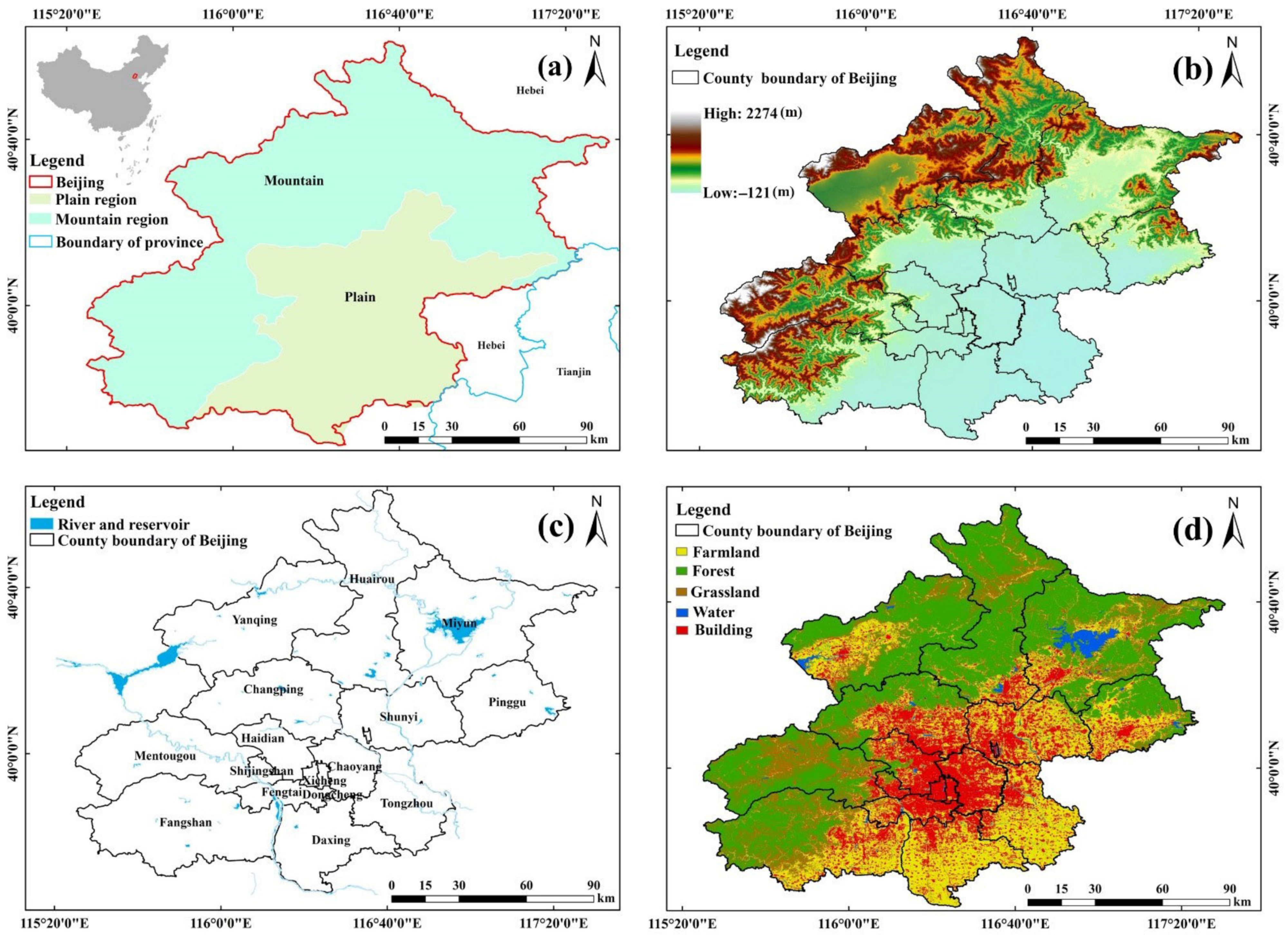
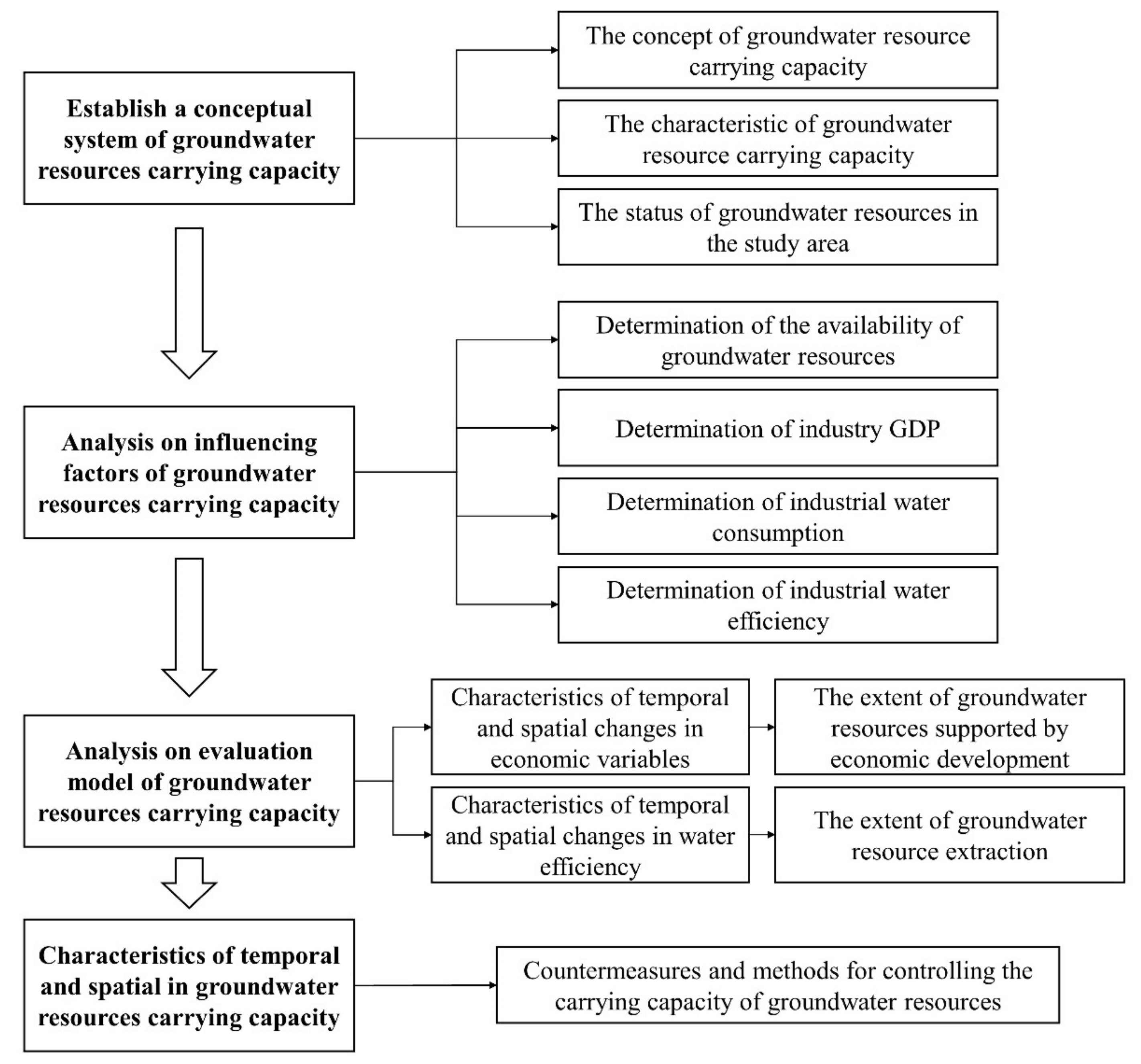

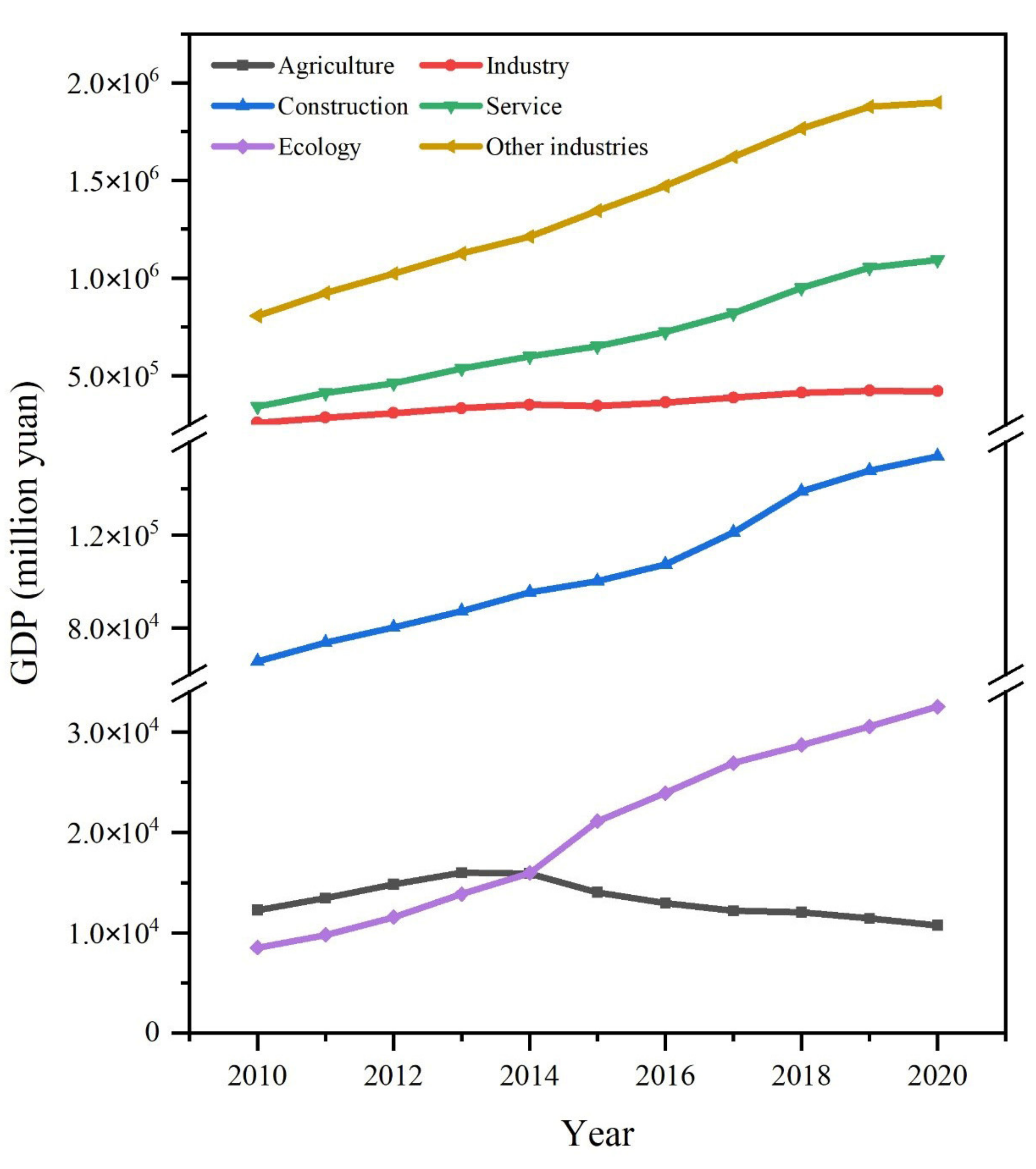

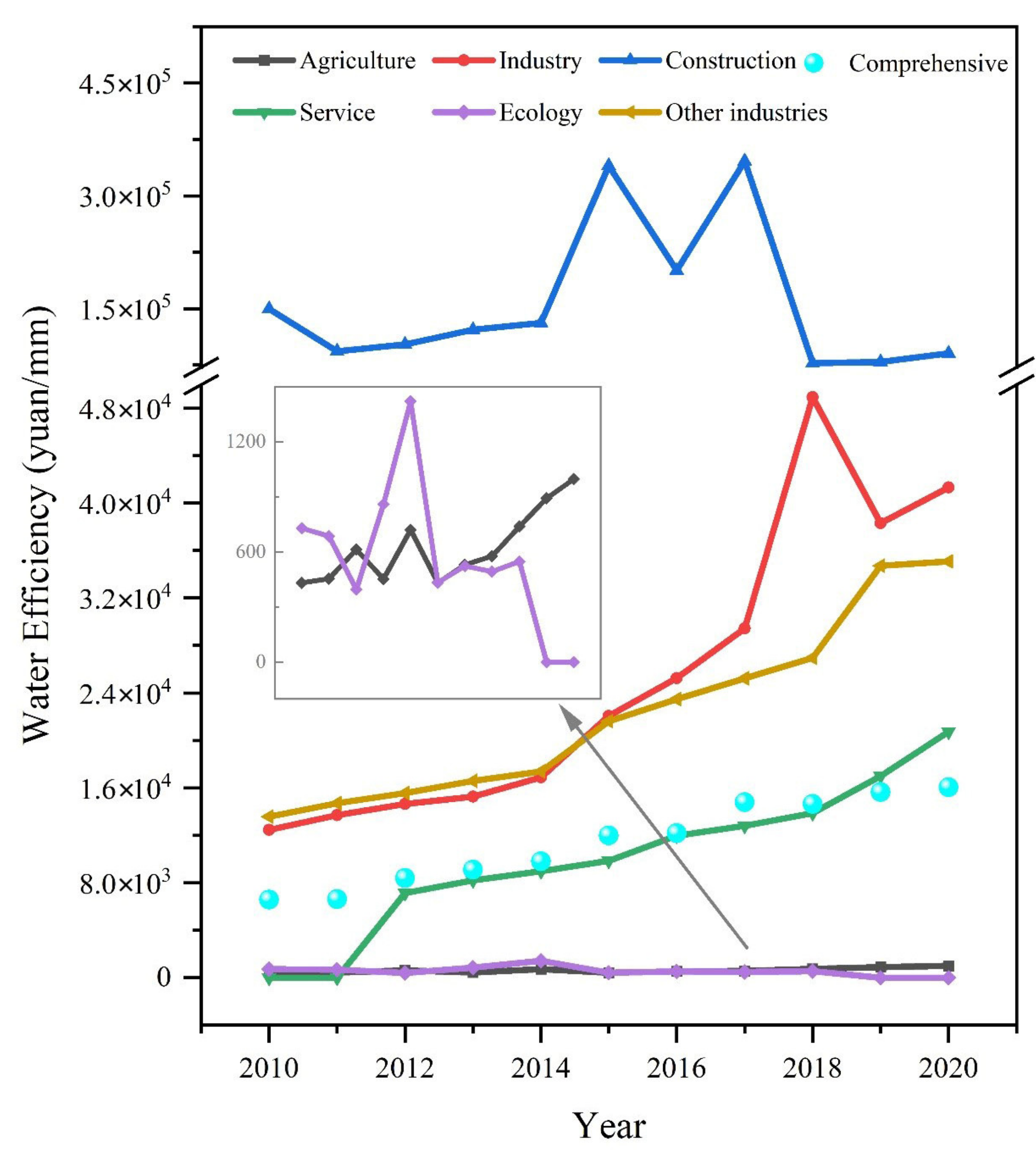
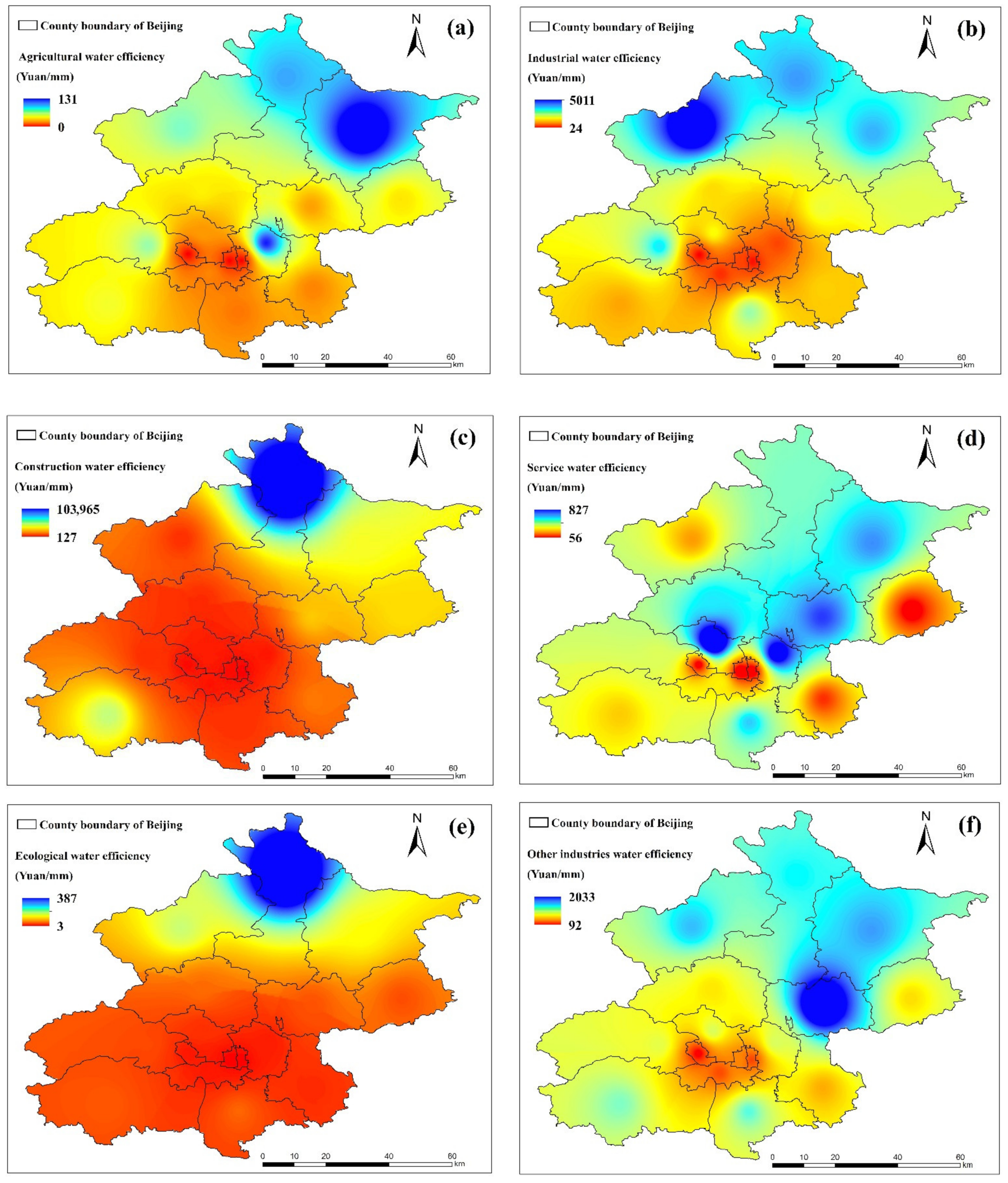
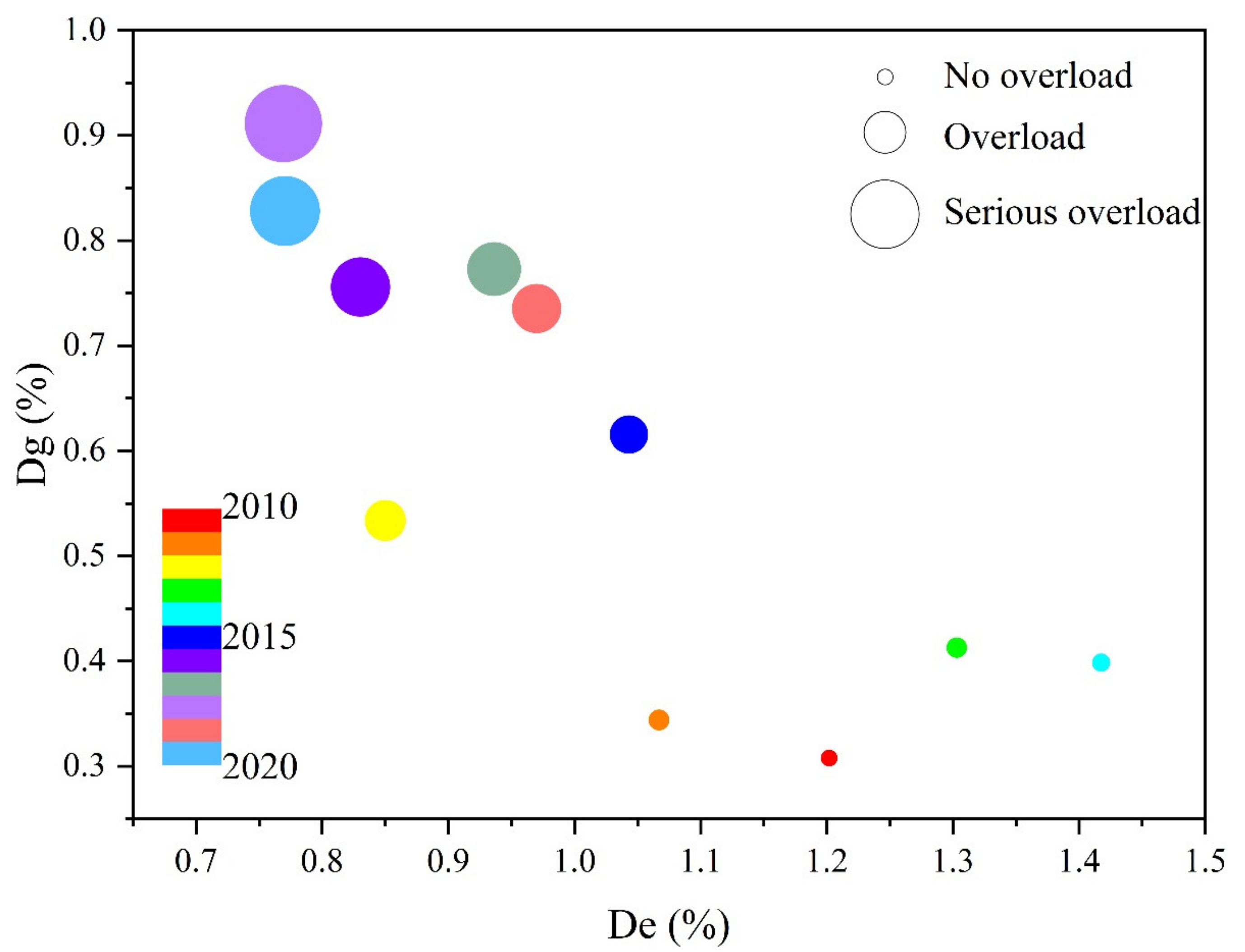
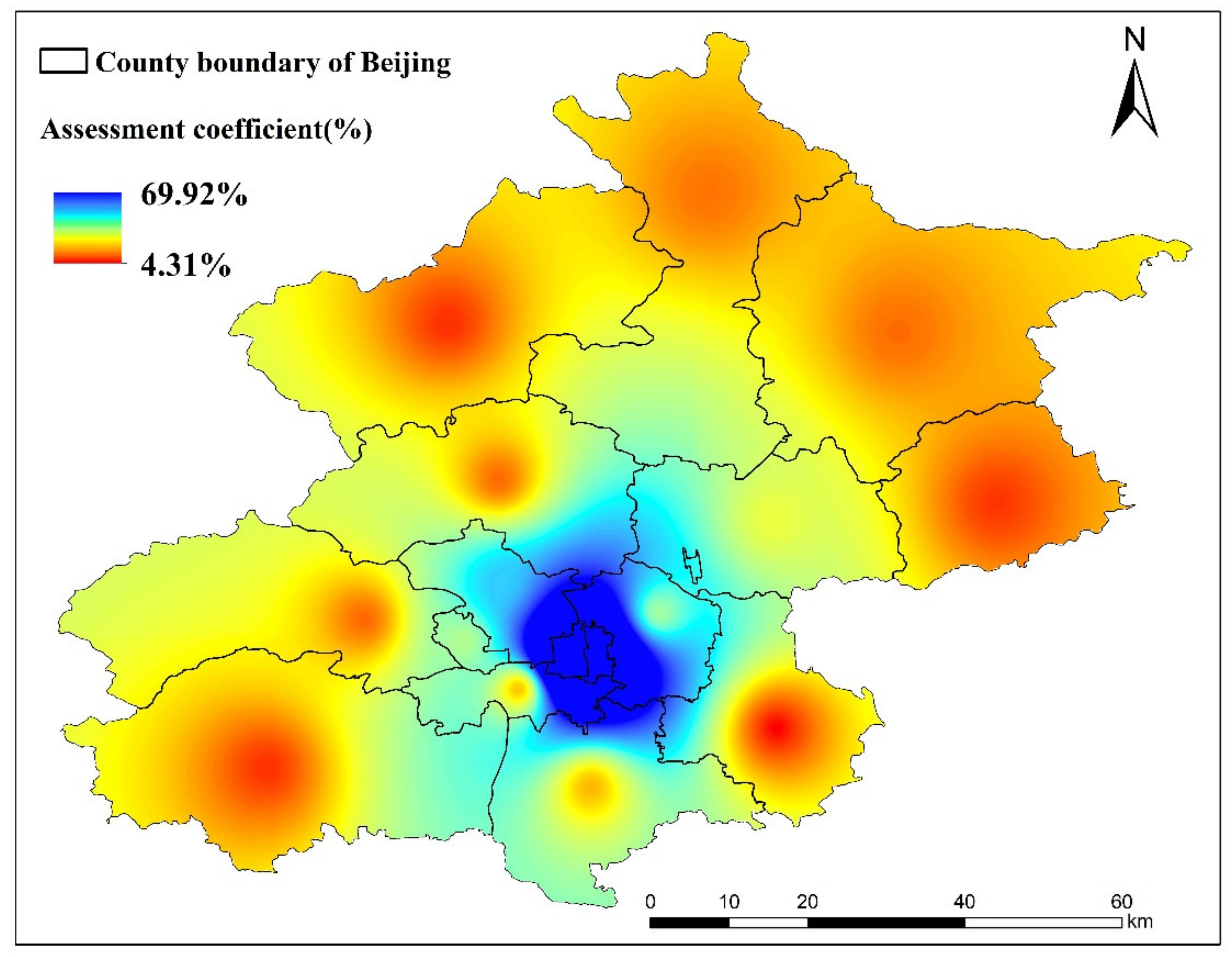
Publisher’s Note: MDPI stays neutral with regard to jurisdictional claims in published maps and institutional affiliations. |
© 2022 by the authors. Licensee MDPI, Basel, Switzerland. This article is an open access article distributed under the terms and conditions of the Creative Commons Attribution (CC BY) license (https://creativecommons.org/licenses/by/4.0/).
Share and Cite
Ge, Y.; Wu, J.; Li, B.; Cao, X.; Wu, J. Analysis and Evaluation of Variation Characteristics in Groundwater Resources Carrying Capacity in Beijing between 2010 and 2020. Sustainability 2022, 14, 9200. https://doi.org/10.3390/su14159200
Ge Y, Wu J, Li B, Cao X, Wu J. Analysis and Evaluation of Variation Characteristics in Groundwater Resources Carrying Capacity in Beijing between 2010 and 2020. Sustainability. 2022; 14(15):9200. https://doi.org/10.3390/su14159200
Chicago/Turabian StyleGe, Yinxin, Jin Wu, Binghua Li, Xiaoyuan Cao, and Jiangyue Wu. 2022. "Analysis and Evaluation of Variation Characteristics in Groundwater Resources Carrying Capacity in Beijing between 2010 and 2020" Sustainability 14, no. 15: 9200. https://doi.org/10.3390/su14159200
APA StyleGe, Y., Wu, J., Li, B., Cao, X., & Wu, J. (2022). Analysis and Evaluation of Variation Characteristics in Groundwater Resources Carrying Capacity in Beijing between 2010 and 2020. Sustainability, 14(15), 9200. https://doi.org/10.3390/su14159200






